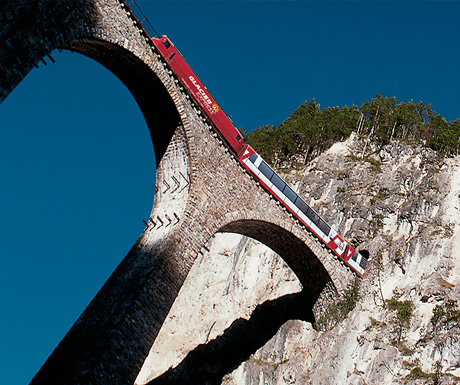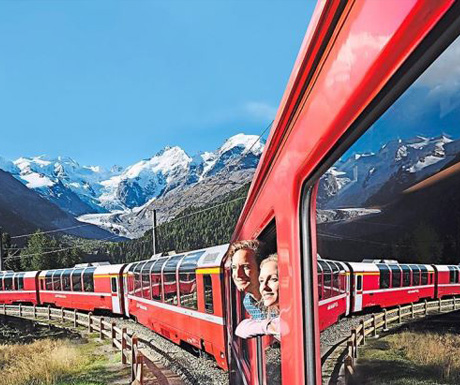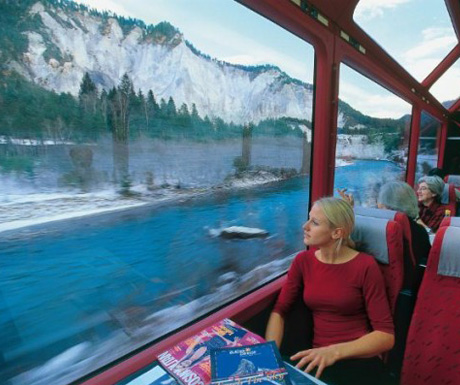Switzerlands, if not Europes, most spectacular train ride, the Glacier Express departs the chic and wealthy resort of St Moritz and around seven hours later arrives in Zermatt, perhaps the worlds most complete ski resort. And what a day out it is too. It is a day trip through virgin mountain landscapes, deep gorges, beautiful valleys, 91 tunnels and crosses 291 impressive and sometimes spectacular bridges.
290kms worth of amazing feats of engineering and wonderful scenery. The majority of the passengers are sightseers, who ride the line in its entirety to take in the spectacular scenery. But its actually possible to hop on and off as much as you like, as long as you reserve seats beforehand.

My journey began in St Moritz, the birthplace of Alpine winter tourism, that enjoys 322 days of annual sunshine, family-friendly slopes and a high concentration of luxury boutiques and high end flag ship stores, stocking some of the worlds most exclusive luxury brands. On a tour of the village, before boarding the train, the luxury and wealth is pretty obvious and in your face. This is the place that the celebrities and aristocracy head for when the snow begins to fall. Its well known that Christina Onassis preferred a helicopter to take her up the mountain rather than using the lifts, with the lesser mortals.
Once on the train, I had a relaxing, three-hour trip ahead of me to Disentis, the second stop after Cher. Once a steam-powered locomotive, that made the first journey in 1930, the Glacier Express is now a modern and very comfortable train. The ambience is cosseting and cosy. In first class, Russian ladies with stretched faces and fur coats converse with their matching fur-coated children, while a Brazilian family Ive befriended informs me that this is their first trip to Europe. We all joke about Swiss efficiency and reliability, which is legendary and quite admirable.

As the train reaches the journeys highest point, the Oberalp Pass at 2033m, a rack-and-pinion system is used to ascend the steep ramps as the train slowly wends its way upward. In fact the Glacier Express has the reputation of being the slowest express train in the world. Possibly because the slow train ride is such a pleasant contrast to our fast-paced lifestyle, its almost a disappointment to have to disembark when the train reaches Disentis.
This rather isolated part of Switzerland proves theres more to the Swiss Alps than expensive bolt holes for the wealthy. This small town, high up in the Rhine Valley, used to be a popular winter holiday destination, but today many of the hotel complexes built in the 1970s are deserted. Instead, the village has become a beacon for off-piste experts.
I hop on the train again for an hour-long trip to Andermatt, a village that doesnt want to suffer the same abandoned fate. With a budget touching two billion Swiss Francs, an Egyptian property developer has set about transforming Andermatt into a world-class ski resort. The project is in its early stages and Andermatt is still a sleepy town, long forgotten by British tourists. I learn that most of Andermatts best runs are accessed via exposed traversing. Not even the mountain guides take their groups here, explains a ski expert I bumped into.

Back on the train for another three hours, the journeys longest tunnel, the Furka Pass, looms up ahead. Until 1982, the Glacier Express operated only in the summer months, because the Furka Pass and the Oberalp Pass were both snowed over in winter. We pass the villages of Brig and Visp before spotting the iconic peak of the Matterhorn ahead of us. With 38 alpine peaks over 4000m, the village of Zermatt at 1608m offers an extensive ski area served by Europes highest cable car, and a glacier that makes skiing possible all year.
The trip was one of the most relaxing experiences that Ive had for a long long time. Next time I think Ill stagger the trip over a couple of days and stop off and take in some skiing in Disentis and Andermatt, I was charmed by both resorts and I learned that the skiing was very challenging. Bring it on!